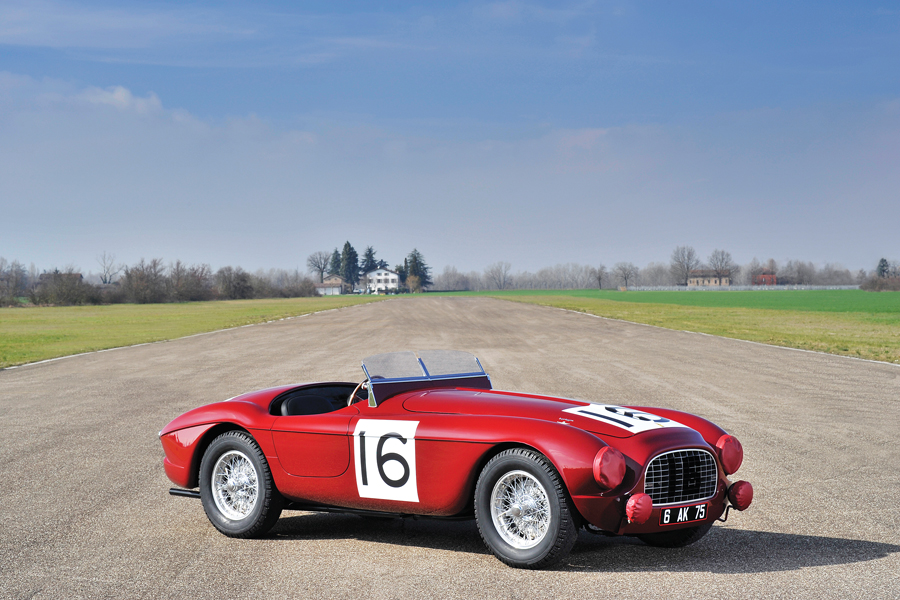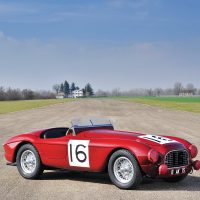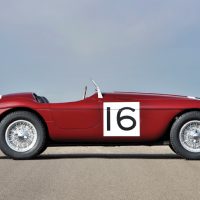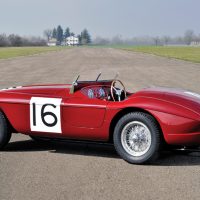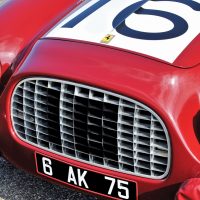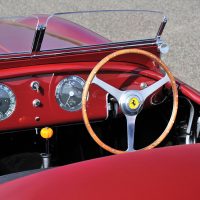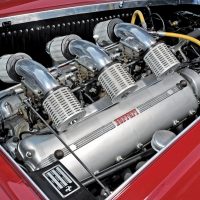SCM Analysis
Detailing
| Vehicle: | 1950 Ferrari 340 America Barchetta by Touring |
| Years Produced: | 1950–52 |
| Number Produced: | 23 |
| Original List Price: | About $14,000 |
| SCM Valuation: | Median to date, $2,530,000; high sale, $8,226,400 (this car) |
| Tune Up Cost: | $4,000 |
| Distributor Caps: | $450 |
| Chassis Number Location: | Left frame member by steering box |
| Engine Number Location: | Right rear of block |
| Club Info: | Ferrari Club of America |
| Website: | http://www.ferrariclubofamerica.org |
| Alternatives: | 1953 Alfa Romeo 6C 2500 SS, 1954 Aston Martin DB3S, 1951 Cisitalia 202MM, 1957 Porsche 550 A, 1950 Jaguar C-type, 1951 Maserati A6GCS/53 |
| Investment Grade: | A |
This car, Lot 232, sold for $8,340,982, including buyer’s premium, at RM Sotheby’s Monaco Auction on May 14, 2016.
“Just think of it! A car in normal road trim, and without any special preparation, is quite capable of breaking the unofficial speed records for production and sports cars by many mph.”
So begins Autosport’s 1951 road test of the Ferrari 4.1-liter America.
Put in contemporary terms, perhaps only a McLaren F1 or a Bugatti Veyron would warrant that prose. That’s how dominant a Ferrari 340 America was in 1951.
Lampredi power
Ferrari wasn’t the first automobile manufacturer to build 12-cylinder engines, but they certainly made the best use of them.
Enzo Ferrari’s vision and Gioacchino Colombo’s engineering produced a near-perfect engine that powered Ferrari’s race and sports cars for decades. Where Colombo’s design had limitations, engineer Aurelio Lampredi stepped in with a competing design.
Ferrari’s choice of engine sizes depended on a complex brew of rule interpretation for whatever form of racing they were contemplating. Lampredi’s solution to Ferrari’s dilemma was displacement. He used size to beat finesse. His logic complemented Ferrari’s belief that the small-engine cars may pass them in the corners but the bigger engine will win on the straights.
Lampredi’s engines were rugged, large-displacement units with features such as cylinder liners that screwed into the head.
Lampredi’s engines were extremely powerful — but more difficult to service. These engines were limited to Ferrari’s most potent racing cars and their most exclusive production cars.
Enzo Ferrari may have felt Formula One was the purest form of racing, but he recognized sports car racing gave him a greater opportunity to sell race cars. Sticking a detuned Formula engine in a sports car chassis allowed him to parlay the technology developed in Formula racing into the lucrative sports car business.
Ferrari’s early sports cars used normally aspirated versions of Ferrari’s supercharged, small-displacement, Colombo-designed 12-cylinder Formula One engines. While the power was sufficient for a small, light race car, an assault by large-displacement Jaguar, Aston, and Mercedes models meant bigger engines were needed.
Fortunately, a new, large-displacement Lampredi engine had been developed for the Formula cars and it could be adapted for sports car use.
As Ferrari expanded his empire towards the United States, he figured the Lampredi-powered cars were a natural fit for the market.
The start of something special
In an effort to draw attention to the brand in the United States, Ferrari developed a 4.1-liter, Lampredi-powered GT that he named the 340 America. The 340 America came in coupe and open-top versions, with bodies by Touring, Vignale and Ghia. As Autosport confirmed, the new 340 America would set the performance standard for the world.
Out of the box, the 340 America would outright win the 1951 Mille Miglia. While few 340s would see competition, the model would be the seed for a line of Lampredi-powered race cars and a line of super-premium “America” models.
While not all were Lampredi-powered, the 340 America would eventually spawn the 375 America, 410 Superamerica, 400 Superamerica, 330 America, 500 Superfast, 365 Spider California, and 575 Superfast.
The best of the breed
Our subject car, chassis 0116A, is a highly desirable Touring Barchetta version. Touring was famous for their patented Superleggera — super-light construction — in which thin tubing was used to build a skeleton for the body skin. Touring built bodies for many of the top manufacturers during the 1940s, 1950s and 1960s.
Few cars in the world are more attractive than the elegant and sporty Ferrari Barchettas. Toss in Touring’s Superleggera construction, add a powerful Lampredi engine — and there’s nothing not to like.
Chassis 0116A has the added value of Le Mans history and celebrity ownership, making it a natural for one of the most valuable cars in the world.
Ferrari collector extraordinaire Pierre Bardinon recognized the value of 0116A and made it part of his Mas du Clos collection of important Ferraris in 1964.
Somewhat surprisingly, Bardinon sold the car in the 1970s, a move he may have later regretted.
During the early 1980s, the car made its way to Ennio Gianaroli, an Italian living in Belgium. Gianaroli was a collector of note and an enthusiast. Over the next couple of decades, he ran the car in many Mille Miglia retrospectives and a variety of other European events.
In 2009 he restored the car to its original Le Mans specs, but he did not compete in the car again.
Chassis 0116A took second billing to a 275 GTB/4 NART Spyder at RM Sotheby’s Monaco auction, but the 340 was the car that brought home the bacon. The NART failed to sell, so it was up to 0116A to save the day.
While chassis 0116A sold under the low estimate, it beat the value guides — and most of the pundits. It is a very significant Ferrari, and the big number was warranted.
Ferrari reserved even-number chassis numbers for their serious race cars, and even-number Ferraris rule the collector car market.
The 340 America is a cornerstone even-number Ferrari. It was the start of the big-bore Ferrari sports racers and the series of ultra-high-end Grand Touring “America” models. With a significant history of ownership and competition, chassis 0116A has few rivals.
It’s reported that the car is heading to Ohio, where the ex-Bardinon 290 MM and the ex-Bardinon 335 S recently moved.
All three were recent top-of-the-market sales, and all three are top-of-the-market cars. Each car has a different owner, but they all reside within hours of each other. Hopefully, someone can stir up some Buckeye pride and bring them together for a reunion. ♦
(Introductory description courtesy of RM Sotheby’s.)
